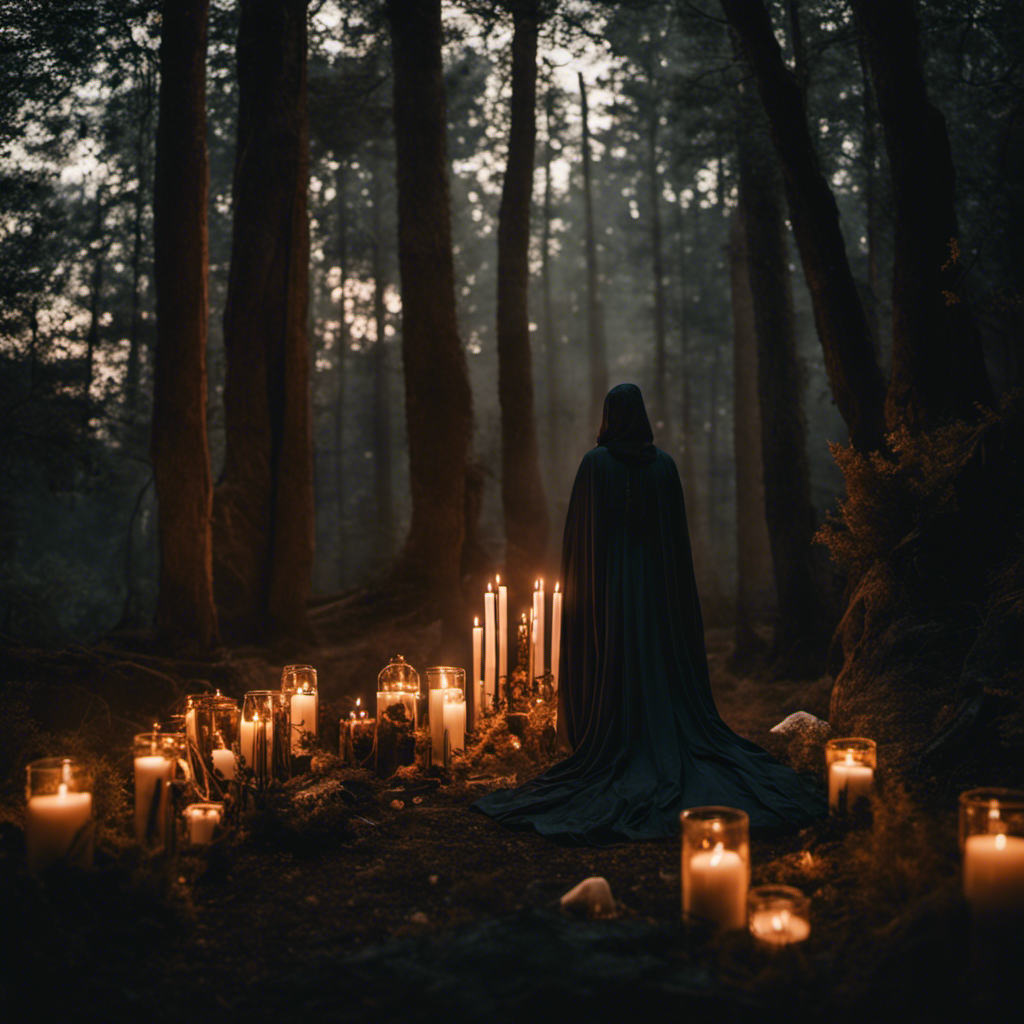Are you curious about Wicca? Well, you’re in luck! In this article, we’ll take you on a journey of exploration into the basics of Wicca.
We’ll delve into its fascinating history, uncover its core beliefs, and discover the rituals and practices that make it unique.
You’ll also learn about the tools and symbols used in Wicca, as well as its deep connection to nature and the elements.
So get ready to debunk common misconceptions and gain a deeper understanding of this ancient spiritual path.
Let’s begin!
The History of Wicca
Wicca’s history is fascinating and full of ancient traditions. To truly understand the origins of Wicca, it is important to explore the influences that have shaped this practice over time.
The spread of Wicca can be attributed to a variety of factors. One significant influence on Wicca was the revival of interest in witchcraft during the 19th and 20th centuries, which led to the development and popularization of modern witchcraft traditions.
Additionally, early proponents such as Gerald Gardner played a crucial role in spreading Wicca through their writings and teachings. The rise of feminism in the 1960s also contributed to its growth, as many women were drawn to its focus on female empowerment and connection with nature.
These influences collectively contributed to the widespread acceptance and practice of Wicca today.
Core Beliefs of Wicca
When practicing Wicca, one of the core beliefs you’ll find is the recognition and reverence for nature as sacred. Wiccans believe that nature is not just a physical entity but also a spiritual force that should be respected and honored. This belief is deeply intertwined with their ceremonies and spellcasting techniques.
Wiccan ceremonies often take place outdoors, where practitioners connect with the natural world around them. They may celebrate the changing seasons, honor specific deities associated with nature, or perform rituals to bring harmony and balance to their lives.
Spellcasting in Wicca involves harnessing the energy within oneself and channeling it towards a specific intention or goal. Nature is seen as a powerful source of this energy, which can be accessed through various practices such as meditation, visualization, or working with herbs and crystals.
The Wheel of the Year
To fully embrace the Wheel of the Year, you’ll need to understand its significance in celebrating the changing seasons and honoring the cycles of nature.
The Wheel of the Year is a central concept in Wicca, representing the cycle of life, death, and rebirth. It consists of eight sabbats or celebrations that mark important points in the year. These sabbats include Samhain, Yule, Imbolc, Ostara, Beltane, Litha, Lammas, and Mabon.
Each sabbat has its own unique rituals and traditions that connect practitioners with nature and their spirituality. By observing these celebrations, Wiccans align themselves with the natural rhythms of the Earth and honor its cycles.
The Wheel of the Year serves as a reminder to live in harmony with nature and to appreciate its beauty throughout all seasons.
Rituals and Practices in Wicca
You can enhance your spiritual practice by incorporating various rituals and practices into your Wiccan journey.
One important aspect of Wicca is the use of rituals to connect with the divine and harness natural energies.
Wiccan spells are a common way to manifest desires and create positive change in your life. These spells often involve gathering specific ingredients, such as herbs or crystals, and performing rituals during certain moon phases.
The moon has a powerful influence on our emotions and energy, so understanding its phases can greatly enhance the effectiveness of your spells. For example, performing a love spell during a waxing moon when its energy is increasing can amplify your intentions for attracting love into your life.
Tools and Symbols in Wicca
By familiarizing yourself with the various tools and symbols used in Wicca, you can deepen your understanding of this spiritual practice.
Wiccan tools are objects that hold symbolic meaning and are used during rituals and spellwork. Some common tools include the athame, which is a ritual knife used to direct energy; the chalice, representing feminine energy and holding sacred liquids; the wand, symbolizing masculine energy and channeling intentions; and the pentacle, a disk inscribed with a pentagram that represents earth’s elements. These tools aid in creating sacred space and connecting with divine energies.
Additionally, Wiccan symbols play an important role in conveying meaning within rituals. The pentacle represents protection and balance, while the triple goddess symbolizes maiden, mother, and crone aspects of femininity. By understanding these tools and symbols, you can enhance your practice by utilizing their powerful energies.
The Goddess and the God in Wicca
When connecting with the Goddess and the God in Wicca, it is important to honor their divine energies and embrace their respective roles in the spiritual practice.
In Wicca, the Divine Feminine and Masculine Energies are represented by the Goddess and the God. The Goddess embodies femininity, fertility, nurturing, and intuition. She is often associated with the moon and cycles of life.
The God represents masculinity, strength, protection, and leadership. He is often associated with the sun and seasons of nature. These deities in Wicca are not seen as all-powerful beings but rather as aspects of a greater divine energy that permeates everything in existence.
Nature and the Elements in Wicca
The elements of nature play a vital role in Wicca. They represent different aspects of life and energy. Elemental correspondences in Wicca are often associated with the four classical elements: earth, air, fire, and water. Each element has its own qualities and symbolism that are incorporated into rituals and spells.
Earth represents stability, grounding, and abundance. Air symbolizes communication, intellect, and inspiration. Fire embodies passion, transformation, and vitality. Water signifies emotions, intuition, and healing. These elemental correspondences provide a framework for understanding the natural world and connecting with its energies in Wiccan practices.
Nature worship is an integral part of Wicca. It recognizes the divinity within all living things. Wiccans revere nature as sacred and view it as a manifestation of the divine. Nature provides inspiration for rituals and spells through its cycles of birth, growth, death, and rebirth.
By working with the elements found in nature – such as using herbs or crystals associated with specific elements – Wiccans tap into their energies to manifest desired outcomes in their lives.
Understanding the elemental correspondences in Wicca allows practitioners to align themselves with the natural world around them while honoring the divine forces at work within it.
Wiccan Traditions and Paths
Now that you have a basic understanding of nature and the elements in Wicca, let’s delve into the world of Wiccan traditions and paths.
In Wicca, there are various traditions or paths that practitioners can choose to follow. Each tradition has its own unique beliefs and practices, but they all share a common reverence for nature and the spiritual realm.
Wiccan ceremonies play a significant role in these traditions. These rituals are conducted to honor the deities, connect with the elements, and celebrate important events such as Sabbats (seasonal celebrations) and Esbats (lunar rituals). Through these ceremonies, Wiccans seek to harness the natural energies around them for personal growth and spiritual connection.
Magical practices are also an integral part of Wicca. These practices include spellcasting, divination, herbalism, meditation, and energy work. Wiccans believe in working with magic to bring positive change into their lives while always adhering to the ethical principle of ‘harm none.’
Ethics and Morality in Wicca
Spellcasting and divination are integral parts of Wiccan magical practices, allowing practitioners to connect with the spiritual realm and seek guidance from higher powers.
Along with these practices, there is a strong emphasis on ethics and moral principles in Wicca. Wiccans follow a code of conduct known as the ‘Wiccan Rede,’ which states, ‘An it harm none, do what ye will.’ This means that practitioners are encouraged to act in ways that do not cause harm to themselves or others.
Additionally, the concept of karma plays a significant role in Wiccan ethics. It is believed that whatever energy or intention you put out into the universe will come back to you threefold. Therefore, Wiccans strive to live responsibly and mindfully, always considering the potential consequences of their actions on themselves and others.
Common Misconceptions About Wicca
Contrary to popular belief, Wicca does not involve worshiping the devil or engaging in harmful practices. It is important to address these misunderstandings and stereotypes surrounding this nature-based spiritual practice.
Wiccans follow a belief system that respects nature and emphasizes personal growth and harmony with the universe. They do not worship any form of evil entity or engage in harmful rituals. Instead, Wiccans celebrate the cycles of nature, honor various deities, and seek to live in balance with the Earth.
The misconception about devil worship arises from a lack of understanding and misinformation perpetuated by mainstream media. By dispelling these stereotypes, we can foster greater understanding and respect for those who practice Wicca as a legitimate spiritual path rooted in reverence for the natural world.
Conclusion
So now you have a better understanding of the basics of Wicca. You’ve delved into its rich history, explored its core beliefs and practices, and learned about the tools and symbols that are integral to this ancient religion.
Just like a tree rooted in the earth, Wicca is deeply connected to nature and the elements. Remember, don’t judge a book by its cover – there are many misconceptions about Wicca that can cloud your perception.
Embrace knowledge like a key unlocking hidden doors, and let it guide you on your own spiritual journey.

